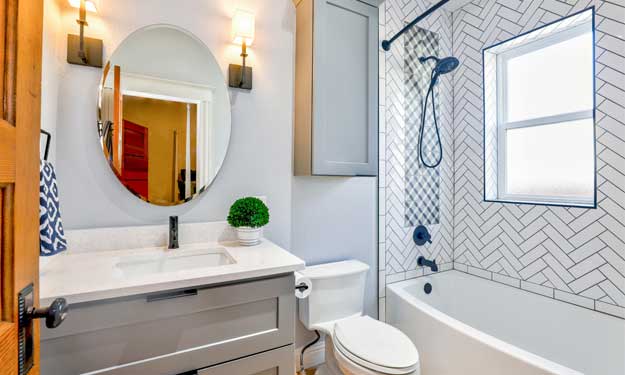How to Clean Ceramic Tiles in the Bathroom

Cleaning Bathroom Tiles.
Bathroom Tips – Cleaning Ceramic Tiles
Ceramic tiles are beautiful and are a common material used in bathrooms. Ceramic tiles are composed of clay, minerals and water, which are shaped into an object and then fired in a kiln until solid.
When we remodeled one of our bathrooms, we chose ceramic tile for the floor and shower because it’s versatile, easy to clean, durable and there were many options to choose from.
When choosing ceramic tile, you will find there are two major differences to choose from: glazed or unglazed.
Glazed Ceramic
Glazed ceramic tile is easier to clean compared to unglazed ceramic. The glaze provides a glass coating for the tile which helps the tile resist stains and scratches. Glazed ceramic is generally more durable than unglazed ceramic because it has to go through an extra firing process.
There are many types of finishes; however the main ones you’ll hear of are gloss vs. matte.
Gloss Finish
You will find semi-gloss and high-gloss ceramic tiles on bathroom walls, countertops and backsplashes.
Pros:
- Easy to clean / virtually stain-proof
- More attractive
- Can make the area seem bigger, as light reflects off of the glaze
Cons:
- Slippery when wet
- Can scratch if you use abrasive cleaners
Matte Finish
You will find matte ceramic tiles on floors and showers.
Pros:
- Dirt is generally less visible
- More slip-resistant than gloss, but less so than unglazed
- Scratch-resistant
Cons:
- Some people do not find matte tiles attractive
Unglazed Ceramic
Unglazed ceramic tile is ideal for high-traffic areas. Although no floor tile is slip resistant, unglazed ceramic tile is generally considered less like likely to cause injury.
Unglazed ceramic should be treated to resist stains, as the tiles can absorb liquids fairly easily. Caution should also be used as unglazed ceramic chips more easily than glazed ceramic.
Precautions When Cleaning Ceramic Tile
Before choosing a cleaning solution, be sure to test the solution in an inconspicuous area to ensure colorfastness and suitability.
Avoid using anything abrasive (steel wool, scouring powder, etc.) as they can damage the finish of your ceramic tile.
Also, avoid using bleach or ammonia-based cleaners, as these are known for discoloring grout.
Remember to always:
- Wipe up stains as soon as possible.
- Vacuum and damp-mop regularly.
- Error on the side of caution: test cleaning solutions in an inconspicuous area before proceeding.
How to Clean Ceramic Tile
Ceramic is generally considered low maintenance when it comes to cleaning. You should always use the solution recommended by your tile manufacturer. Many places recommend using “pH-neutral” cleaners as they won’t harm the finish on ceramic or discolor the grout.
Regular Care and Maintenance
One of the most important things is to make sure you clean up spills immediately, as they could discolor the grout or damage the finish of your ceramic. Dirt is the biggest enemy when it comes to ceramic tile.
If dirt is left to sit, the chances of it scratching ceramic or getting embedded in any pre-existing scratches increases significantly. Countertops can also accumulate dirt and debris and need to be cleaned regularly as well.
A great preventative maintenance tool is a floor mat, especially for high-traffic areas.
- Sweep regularly or vacuum the tiles to remove any dust or dirt particles.
- Damp-mop your floors once a week (or more in high-traffic areas) with warm water. Vacuum first.
- Dry.
Note: Unglazed ceramic tile should only be cleaned with pH-neutral cleansers. They are specifically formulated to remove grease, oil, and spills that accumulate on unglazed surfaces.
Heavy Duty Cleaning
If the ceramic tile hasn’t been cleaned in while, it could probably benefit from a deep cleaning.
Follow all of the steps outlined in “Regular Care and Maintenance,” but instead of using plain water you can add just a few drops of Dawn dishwashing liquid. It is important not to use detergents or soaps too frequently, as they can cause ceramic to look dull.
After mopping with the soapy water, rinse (this is important!) with clean water to remove any leftover residue, and then dry.
Hard Water Stains
Hard water stains are normal; they develop when water has a high mineral content and is left to evaporate on a surface.
Acid based tile cleaners are best for cleaning these stains, but use caution – wear gloves and make sure the area is well-ventilated.
Full strength vinegar (a mild acid) and elbow grease will help dissolve the hard water deposits as well.
Mold and Mildew
The bathroom is the perfect breeding ground for mold and mildew. High humidity, minimal air flow and low light all contribute to the growth of these bacteria. Get your safety equipment (gloves and goggles) and in a well-ventilated area, do the following:
- Mix 2 cups Oxi-Clean with 1 gallon of warm water.
- Work in sections and use a nylon brush to scrub the area.
- Let sit (for up to an hour).
- Scrub for another 5 minutes.
- Rinse thoroughly and dry.
Enjoy Your Clean Tiles
After a long day and everyone’s in bed, slip into a nice warm tub and relax. You deserve it!

